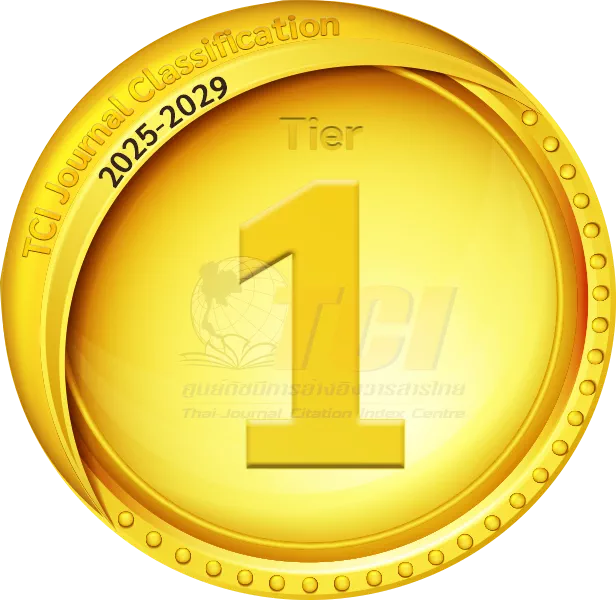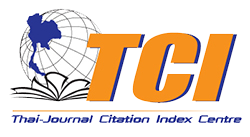การใช้เทคโนโลยีพลาสมาเย็นเพื่อเพิ่มประสิทธิภาพการตายของเซลล์กลัยโอบลาสโตมา
Cold Atmospheric Plasma Technology for Enhancing Glioblastoma Cell Death
Abstract
เนื่องจากในปัจจุบันมะเร็งสมองชนิดร้ายแรงเป็นมะเร็งที่มีความรุนแรงสูงและรักษาได้ยาก พบมากถึงร้อยละ 45 ของมะเร็งสมองทั้งหมด ดังนั้นผู้วิจัยจึงมีความประสงค์ทำการศึกษาหาแนวทางให้การรักษามะเร็งสมองชนิดร้ายแรง โดยงานวิจัยนี้มุ่งเน้นศึกษาการใช้พลาสมาเย็นเพื่อกำจัดเซลล์มะเร็งสมองชนิดกลัยโอบลาสโตมา โดยใช้เครื่องพลาสมาเจ็ทรุ่นไนติงเกล ทำการออกแบบการทดลองแบบแฟกทอเรียลเต็ม ศึกษาปัจจัย 4 ปัจจัย ได้แก่ ระดับความเข้มพลาสมา อัตราการไหลของอากาศ ระยะห่างระหว่างอิเล็กโทรดกับผิวของมีเดีย และเวลาในการดิสชาร์จพลาสมา ผลการทดลองพบว่า พลาสมาเย็นสามารถกำจัดเซลล์มะเร็งได้สูงสุด 49.91% ภายใต้เงื่อนไขที่ดีที่สุด ระดับความเข้มพลาสมา 0.62 วัตต์ อัตราการไหลของอากาศ 3 ลิตร/นาที ระยะห่างระหว่างอิเล็กโทรดกับผิวของมีเดีย 2 เซนติเมตร และเวลา 210 วินาที จำนวนการตายของเซลล์ถูกตรวจวัดด้วยวิธีการย้อมสีไทรแพนบลู และทำการศึกษาสัณฐานวิทยาของเซลล์ด้วยการย้อมสารเรืองแสง (โพรพิดิอุมไอโอไดด์และโฮชสต์ 33342) และจากการทดลองในโครงร่าง 3 มิติ แสดงผลการกำจัดเซลล์มะเร็งได้สูงสุด 23.00% อย่างไรก็ตาม พลาสมาเย็นมีศักยภาพในการสร้างอนุมูลอิสระของออกซิเจนและไนโตรเจนที่ส่งผลต่อการตายของเซลล์มะเร็ง งานวิจัยนี้ชี้ให้เห็นถึงความเป็นไปได้ในการพัฒนาเทคโนโลยีพลาสมาเย็นเป็นวิธีการรักษามะเร็งสมองในอนาคต แต่ยังจำเป็นต้องศึกษาขั้นสูงเพิ่มเติมเพื่อปรับปรุงประสิทธิภาพและการใช้งานในระดับคลินิกต่อไป
Currently, aggressive brain cancer is one of the most severe types of cancer and is difficult to treat. It accounts for up to 45% of all brain cancers. Therefore, the researcher aims to study and explore potential approaches for treating aggressive brain cancer. This study focuses on utilizing Cold Atmospheric Plasma (CAP) to eliminate glioblastoma cells (LN229), an aggressive form of brain cancer. The experiments employed the Cool Air Plasma Jet model Nightingale and implemented a Full Factorial Design (2k) to investigate four factors: plasma intensity level, airflow rate, electrode-to-media surface distance, and plasma discharge duration. The findings revealed that cold plasma achieved a maximum cancer cell elimination rate of 49.91% under optimal conditions: plasma intensity at 0.62 watts, airflow rate at 3 liters per minute, electrode-to-media distance at 2 cm, and discharge time of 210 seconds. Cell death was quantified using trypan blue staining, while cell morphology was studied via fluorescence staining with propidium iodide and Hoechst 33342. In three-dimensional models, the maximum cancer cell elimination rate was 23.00%. The results suggest that cold plasma has significant potential in generating Reactive Oxygen and Nitrogen Species (RONS), which contribute to cancer cell apoptosis. This research highlights the potential of cold plasma technology as a future treatment for brain cancer. However, further advanced studies are required to enhance its efficacy and applicability at the clinical level.
Keywords
[1] N. Takerngdej. (2021). GBM: Jod Mai Rak the Letter. Ramkhamhaeng Hospital. [Online] (in Thai). Available: https://www.ramhosp. co.th/news_detail/769
[2] J. Chindaprasirt, K. Wirasorn, and A. Sookprasert. (2015). High-grade glioma brain tumor: Treatments and molecular markers. [Online] (in Thai). Available: http://www.smj. ejnal.com/e-journal/showdetail/?show_ detail=T&art_id=1943
[3] National Cancer Institute of Thailand. (2018). Hospital-based cancer registry 2018. [Online] (in Thai). Available: https://www.nci.go.th/th/ cancer_record/cancer_rec1.html
[4] National Cancer Institute of Thailand. (2019). Hospital-based cancer registry 2019. [Online] (in Thai). Available: https://www.nci.go.th/th/ cancer_record/cancer_rec1.html
[5] National Cancer Institute of Thailand. (2020) Hospital-based cancer registry 2020. [Online] (in Thai) Available: https://www.nci.go.th/e_ book/hosbased_2563/index.html
[6] National Cancer Institute of Thailand. (2021) Hospital-based cancer registry 2021. [Online] (in Thai) Available: https://www.nci.go.th/e_ book/hosbased_2564/index.html
[7] National Cancer Institute of Thailand.(2022) Hospital-based cancer registry 2022. [Online] (in Thai)Available: https://www.nci.go.th/th/ cancer_record/cancer_rec1.html
[8] N. Hirankarn.( 2019). Cellular immunotherapy research for cancer. [Online] (in Thai) Available:https://kcmh.chulalongkornhospital. go.th
[9] A. Kazemi, M. J. Nicol, S. G. Bilén, G. S. Kirimanjeswara, and S. D. Knecht, “Cold atmospheric plasma medicine: Applications, challenges, and opportunities for predictive control,” Plasma, vol. 7, no. 1, pp. 233–257, 2024.
[10] H. Tanaka, M. Mizuno, K. Ishikawa, K. Nakamura, H. Kajiyama, H. Kano, F. Kikkawa, and M. Hori, “Plasma-activated medium selectively kills glioblastoma brain tumor cells by downregulating a survival signaling molecule, AKT Kinase,” Plasma Medicine, vol. 1, pp. 265–277, 2011.
[11] G. Bauer, D. Sersenová, G. David, and Z. Machala, “Cold atmospheric plasma and plasma-activated medium trigger RONS-based tumor cell apoptosis,” Scientific Reports, vol. 9, no. 1, pp. 14210, Sep. 2019.
[12] U. S. Srinivas, B. W. Tan, B. A. Vellayappan, and A. D. Jeyasekharan, “ROS and the DNA damage response in cancer,” Redox Biology, vol. 25, pp. 101084, Jan. 2019.
[13] D. Yan, A. Talbot, N. Nourmohammadi, J. Sherman,X. Cheng, and M. Keidar, “Toward understanding the selective anticancer capacity of cold atmospheric plasma - A model based on aquaporins,” Review, vol. 10, no. 4, Dec. 2015.
[14] A. Sakunphueak, “Free radicals and antioxidants,” CCPE, 2016.
[15] A. Phaniendra, D. Jestadi, and L. Periyasamy, “Free radicals: Properties, sources, targets, and their implication in various diseases,” PMC, vol. 30, pp. 11–26, 2015.
[16] K. Moonsup, S. Udomsom, and W. Wattanutchariya, “Impact of plasma treatment on cancer cell culture in 3D biomaterial scaffold,” Naresuan University Engineering Journal, vol. 12, no. 2, pp. 111–120, Jul.–Dec. 2017 (in Thai).
[17] J. Köritzer, V. Boxhammer, A. Schäfer, T. Shimizu, T. G. Klämpfl, Y. F. Li, C. Welz, S. S. Zieger, G. E. Morfill, Julia L Zimmermann, and Jürgen Schlegel, “Restoration of sensitivity in chemoresistant glioma cells by cold atmospheric plasma,” PLoS One, vol. 8, no. 5, pp. e64498, May 2013.
[18] J. Privat-Maldonado, A. L. O'Connell, S. Welch, S. V. Milosavljević, A. S. Stack, J. G. V. Mirabal, S. Flynn, M. Mennillo, M. Keidar, J. C. Gill, J. M. Lyng, and P. Bourke, “Auranofin and cold atmospheric plasma synergize to trigger distinct cell death mechanisms and immunogenic responses in glioblastoma,” Cells, vol. 10, no. 11, pp. 2936, Nov. 2021.
[19] D. C. Montgomery, Design and Analysis of Experiments, 10th ed. Hoboken, NJ, USA: Wiley, 2019.
[20] N. Vichiansan, K. Chatmaniwat, M. Sungkorn, K. Leksakul, P. Chaopaisarn, and D. Boonyawan, “Effect of plasma-activated water generated using plasma jet on tomato (Solanum lycopersicum L. var. cerasiforme) seedling growth,” Journal of Plant Growth Regulation, vol. 42, no. 2, pp. 935–945, 2022.
[21] N. Chairuang, “The effect of inconsistency between assessment standards and teachers’ evaluation on mathematics learning achievement of mathayomsuksa 4 students in Chiang Mai province,” M.S. thesis, Sukhothai Thammathirat Open University, 2020 (in Thai).
[22] D. C. Montgomery and G. C. Runger, Applied Statistics and Probability for Engineers, 6th ed., Wiley, 2014.
[23] M. Keidar, D. Yan, I. Beilis, B. Trink, and J. H. Sherman, “Plasmas for cancer treatment,” Physics of Plasmas, vol. 25, no. 8, 083504, 2018.
[24] A. Azzariti, R. M. Iacobazzi, R. Di Fonte, L. Porcelli, R. Gristina, P. Favia, F. Fracassi, I. Trizio, N. Silvestris, G. Guida, S. Tommasi, and E. Sardella, “Plasmaactivated medium triggers cell death and the presentation of immune activating danger signals in melanoma and pancreatic cancer cells,” Scientific Reports, vol. 9, no. 40637, 2019.
[25] J. Mrotzek and W. Viöl, “Spectroscopic characterization of an atmospheric pressure plasma jet used for cold plasma spraying,” Applied Sciences, vol. 12, no. 13, pp. 6814, 2022.
[26] R. Sato, Y. Morimoto, M. Hirayama, T. Matsuura, and S. Takeuchi, “3D culture of tumor cells using microfabricated devices for cellular analysis and drug screening,” Analytical Sciences, vol. 36, no. 2, pp. 203–210, 2020.
DOI: 10.14416/j.kmutnb.2025.05.001
ISSN: 2985-2145





